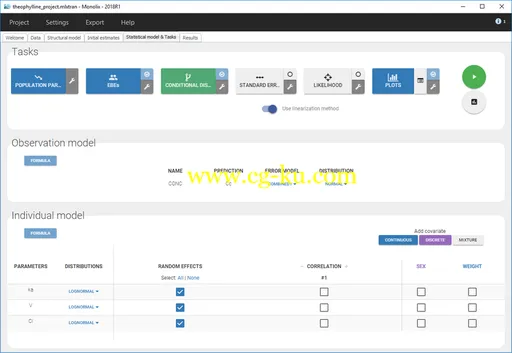Lixoft Monolix是基于药物模型开发参考的平台。
它结合了最先进的算法具有独特的易用性。
药物计量学家和生物统计学习可以依靠Monolix进行生物分析,并去模型PK/PD和其它复杂的生化和生理过程。
Monolix是一种简单,快捷,功能强大的工具,适用于参数估计的非线性混合效应模型,模型诊断和评估,以及先进的图形表示等。
File size: 135 MBMonolix is the most advanced and simple solution for non-linear mixed effects modeling (NLME) for pharmacometrics.
It is based on the SAEM algorithm and provides robust, global convergence even for complex PK/PD models.
Monolix is used for preclinical and clinical population PK/PD modeling and for Systems Pharmacology.
Monolix enjoys a large user community.
Monolix is widely used by academia, the pharmaceutical industry as well as the US regulatory agencies.
Advanced Statistical MethodologiesReliable convergence for all type of data is a centerpiece in population PKPD modeling, which is why Lixoft pioneered in collaboration with Inria the SAEM algorithm.
Automated generation of diagnostic testsMonolix automatically generates a full set of diagnostic plots even for complex PK/PD models.
For example, you can instantaneously create the Visual Predictive Check, split by any patient subgroup you would want to investigate.
Increased productivity and qualityEfficient C++ solver package, standardized model language with Mlxtran, PK/PD model library and integrated software all contribute to better productivity and quality.
Very easy to use with its GUIOur solutions are designed for ease of use.
Monolix can be used via a graphical interface or command lines for powerful scripting.
This means less programming for you and more focus on exploring models and pharmacology to deliver in time to your customers.
Key features:Support of all relevant data types and statistical featuresMonolix covers a wide range of data types and statistical features for population PK/PD modeling.
For all cases the right statistical methodology has been developed and published for reference.
Monolix covers:Continuous, categorical, count and repeated time to event data.
Mixture models and mixtures of models.
Inter-occasion variability with any number of levels.
Proper handling of BLQ data.
Normal, lognormal, logit, probit and user defined distributions for the individual parameters.
